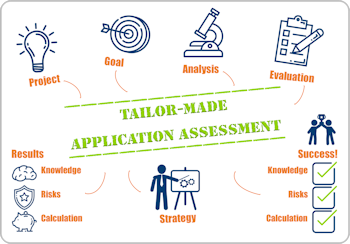 Dear Reader,
Dear Reader,
As much as the pandemic restricts us - professionally as well as privately: it creates the opportunity for many companies to tackle long-needed projects in software development.
The modernisation as well as the re-implementation and maintenance of your applications cause high costs and considerable risks for the operational business. You can reduce costs and, above all, risks through automated solutions.
Find out today about automated assessments, complete analyses and customised clean-ups that can help you make better use of your resources and reduce risks for your projects.
We hope you enjoy reading and welcome any feedback!
Your Delta Software Technology Team
 3 Important Steps for the Sustainable Software Modernisation
3 Important Steps for the Sustainable Software Modernisation
You value the reliability, speed and functionality of your COBOL and PL/I applications?
These applications are an indispensable part of your application landscape for you in the future?
You want your operational back-end applications to be permanently of good quality?
But: You also want to implement changes quickly and benefit from new technologies. You want to play it safe with all changes.
We show you 3 steps that will help you modernise your applications securely and sustainably.
3 Important Steps for the Sustainable Software Modernisation
3 Important Steps for the Sustainable Software Modernisation
- Do you value the functionality and reliability of your COBOL and PL/I applications?
- Are you struggling with the complexity and do you lack precise knowledge about the implementation of the functionality?
- Have you also been reducing your investment in existing backend applications for a long time and your experts and knowledge carriers are on their way to retirement?
- Do you want to modernise your operational backend applications and benefit from new technologies while playing it safe with all changes?
We discuss 4 steps that will help you to modernise your applications securely and sustainably. Read now:
Best Practices for Application Modernisation
Although there are countless reasons for application modernisation, the overarching goal is always to reduce the risks of legacy applications, save costs, increase organisational agility with modern IT and, last but not least, be attractive to new specialists.
The following 4 steps will help you to modernise your applications securely and sustainably.
- Custom-fit Assessments for good decisions: For detailed information, read ‘4 Important Steps for Sustainable Software Modernisation (Step 1: Custom Fit Assessments)’
- Automated Application Analysis for a comprehensive and accurate (re)understanding of the implemented application logic in order to reduce risks and costs for modernisation or new implementation and ensure easy knowledge transfer. For detailed information, read ‘4 Important Steps for Sustainable Software Modernisation (Step 2: Automated Application Analysis)’
- Agile Clean-up to optimise the use of your resources.
- Fully Automated Transformation for a completely secure and flexible modernisation.
Simplify Your Legacy Application Modernisation
For almost 50 years, our customers have benefited from our automated solutions to develop their customised IT applications securely and sustainably while reducing costs and risks. From our experience with very large projects, we can say that most of the applications developed in COBOL and PL/I or created by generators are very large and complex because the business logic they implement is extensive and complex.
Application size, complexity and strong interconnectivity of the individual components, code that is no longer required in the applications as well as a lack of knowledge about the applications' implementation and inappropriate documentation hinder safe, effective and efficient modernisation.
So, how do you gain a comprehensive and accurate understanding of the applications that enables secure modernisation and flawless transformation of your valuable legacy applications into future-proof applications?
So, how can you attain good decisions and realistic planning, get a comprehensive and accurate understanding of the applications and execute a reliable clean-up that enables a secure modernisation and error-free transformation of your valuable legacy applications into future-proof applications?
Step 1: Custom-fit Assessments
Step 1
Custom-fit Assessments for Good Decisions
So, how can you attain good decisions and realistic planning that enables a secure modernisation and error-free transformation of your valuable legacy applications into future-proof applications?
The solution is an assessment. But, be careful: It is not enough - as many providers propose - to simply list a few figures about the approximate size and number of modules in order to receive reliable estimates of the effort and costs. The risks, as so often, lie in the details.
Of course, rough decisions and gut feeling could also lead to success. As a rule, however, they lead to delays (also in other projects) and significant cost increases and, unfortunately, often also to the failure of modernisation projects.
In its Chaos Report 2019, the Standish Group reports that 83.9% of IT projects fail partially or completely. The following reasons for failure are repeatedly cited in studies:
- Badly defined requirements
- Poorly defined or unrealistic planning
- Inaccurate and unrealistic estimates
The modernisation projects that we have implemented for large financial service providers have shown that only a complete analysis of all sources in advance provides reliable information. The emphasis here is placed on Complete and All. This is the only way to recognize all obstacles and dependencies. This is the only way to make good decisions and eliminate the risks.
Tailor-made Assessment - Why?
Simply collecting all the data about your applications will not help you to reliably assess the risks and costs of extensive changes. This can only be achieved by an analysis that is precisely tailored to your project goal and your applications.
Our projects have shown us that a targeted and individually tailored analysis of the applications is a crucial basis for:
- The exact definition of the requirements
- Reliable planning
- Inaccurate and unrealistic estimates
The modernisation projects that we have implemented for large financial service providers have shown that only a complete analysis of all sources in advance provides reliable information. The emphasis here is placed on Complete and All. This is the only way to recognize all obstacles and dependencies. This is the only way to make good decisions and eliminate the risks.
Tailor-made Assessment - Why?
Simply collecting all the data about your applications will not help you to reliably assess the risks and costs of extensive changes. This can only be achieved by an analysis that is precisely tailored to your project goal and your applications.
Our projects have shown us that a targeted and individually tailored analysis of the applications is a crucial basis for:
- The exact definition of the requirements
- Reliable planning
- The realistic assessment of the risks and efforts
A tailor-made assessment finds all stumbling blocks and helps to precisely define the requirements for a project, enables precise planning and thus paves the way for the successful implementation.
What Can We Do for You?
If you want to ensure the success of your modernisation projects, find out about the possibilities of our tailor-made application assessments.
You can find an initial overview in our flyer “Application Assessment: Don't Guess – Assess”.
Download Language: Englisch - Version: mt21085.02

Tailor-made application assessments enable you to pinpoint and to reliably evaluate all critical issues for your projects. They help you to accomplish your projects in the areas of modernisation, migration, mass changes and clean-up of your COBOL and PL/I applications successfully in time and in budget.
Read moreEvery project is different and our flyer just gives you a first general idea. To get the best solution for you, you should directly discuss the requirements and details of your project with us.
Step 2: Automated Application Analysis
Step 2
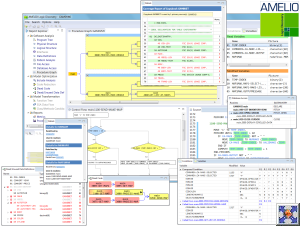 Automated Application Analysis – Why?
Automated Application Analysis – Why?
Regardless of whether you want to modernise the functionality of your backend applications by changing the data management system or replacing individual technology modules, or whether you want to redevelop them using ‘modern’ languages, you always need to know exactly what is currently implemented and how it is implemented.
Understanding large and complex applications is a Herculean task! Especially if you have not developed the applications yourself and even more so if the original developers are no longer available. The documentation - if available and up-to-date - does not provide the knowledge about the implementation of the functionality that is necessary for understanding and modernising or rewriting.
Even if the applications were originally well structured, this design has often suffered over the decades. Old architectures and techniques are used. New code was repeatedly added to fulfil new requirements. However, code that was no longer needed was rarely removed, as there was no real certainty that this code was no longer needed under any circumstances and the cost and effort of testing was spared. It is generally estimated that the proportion of ‘dead code’ in applications increases by around 10% per decade. This also prevents precise understanding.
Poor understanding of existing applications leads to
- poorly or even incorrectly defined requirements
- poorly defined and unrealistic planning
- unrealistic estimates of risks and expenses
- errors during modernisation or new implementation
Read also ‘Chaos Report 2019 by the Standish Group’ for more details.
In addition, a lack of understanding of existing applications usually also leads to delays (also in other projects) and significant cost increases and, unfortunately, often to the failure of modernisation projects.
Really Understanding Applications – A Dream?
The truth or rather the entire knowledge about your applications, their functionality and their actual implementation is in the current source code!
But beware: It is not enough - as many providers propagate - to simply visualise the application code, data usage and possibly also the dependencies. Some tools, especially those that are also used for maintenance, also offer step-by-step execution of the code. All of this is not enough to really understand the applications and their implementation.
But, the good news is: this knowledge can be recovered quickly using our automated application analysis.
Proper Structuring and Logical Abstraction
Real understanding can only be gained through the right structuring and logical abstraction, through the ability to view the analysed code under varying aspects and from different perspectives and, above all, to be able to abstract the implementation across multiple levels.
The aim is not only to visualise the physical code and data structures, but also to determine the logical components of the source code and the conditions for their interaction. This is the only way to derive the implemented functions, their interfaces and the conditions for their execution.
To simplify knowledge transfer, onboarding and subject-specific communication, the information also needs to be presented in a language-neutral way.
Automated Application Analysis with AMELIO Logic Discovery
AMELIO Logic Discovery is an innovative analysis tool that helps you to better understand your native and generated COBOL, PL/I and Delta ADS applications and to comprehensively secure the relevant functionality.
Through in-depth and comprehensive analyses of the applications, AMELIO Logic Discovery determines
- what is implemented
- how it is implemented
- which logical relationships exist
- which components form a logical unit (procedures, composites, ...)
- the conditions under which procedures and components are called or executed
- what the interfaces of these components look like
- which data structures are used, how and where (definition, scope, ...)
 The implementation details are abstracted, the information obtained is connected, logically structured and the knowledge about the functionality of the application is derived. The result is a clear, language-neutral and technology-independent visualisation of the application logic, in which users can navigate freely across all levels, in topic-related views and in selectable levels of detail, so that your teams can easily understand the applications.
The implementation details are abstracted, the information obtained is connected, logically structured and the knowledge about the functionality of the application is derived. The result is a clear, language-neutral and technology-independent visualisation of the application logic, in which users can navigate freely across all levels, in topic-related views and in selectable levels of detail, so that your teams can easily understand the applications.
The modernisation projects we have accomplished for large companies have shown that a precise understanding of the functionality of the existing applications and their implementation is essential for the success of modernisation projects.
AMELIO Logic Discovery offers new, flexible and well-structured views of our applications. Especially the logical views help to find and understand the crucial points in our applications.
Marcel Rozema (Senior Software Architekt, RDW)
AMELIO Logic Discovery offers you a reliable basis for your application modernisation, for the elimination of technical debt, for decisions on the next development steps, for new development with modern languages and for many other tasks.
The AMELIO Tool Family
AMELIO Logic Discovery can be extended according to your specific needs. For example, it is possible to use code-smell analyses to determine whether company-specific coding standards are being violated and, if so, where. For modernisation projects, the ‘points of interest’ and thus possible crucial points can be determined automatically.
Especially for clean-up and modernisation projects, AMELIO Logic Discovery can be combined with other tools from the AMELIO family to perform the necessary changes to the source code in a fully automated and audit-proof manner.
Our tools help you to analyse COBOL, PL/I and Delta ADS applications in a targeted manner, to adapt them quickly and securely to new requirements and technical infrastructures and to reliably assess risks.
This (and more) is what we can do for you!
If you want to reduce the risks and costs for your modernisation projects and to make it easier for your teams to really (re)understand your applications, then find out now about the possibilities of our automated application analysis with AMELIO Logic Discovery.
We offer you an initial overview in our flyer ‘Analysis for COBOL & PL/I - (re)understanding applications’
Download Language: Englisch - Version: MT21098.02

AMELIO Logic Discovery is an innovative analysis tool that helps you to better understand your native and generated COBOL, PL/I and Delta ADS applications and to comprehensively secure the relevant functionality.
Read moreFurther information on AMELIO Logic Discovery can also be found here:
AMELIO Logic Discovery: Really Understanding COBOL, PL/I, Delta ADS Applications
Every project is different and our flyers only give you an initial overview. To get the best solution for you, you should discuss the requirements and details of your project with us directly.
Step 3: Agile Clean-up
Step 3
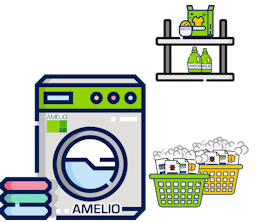 First Clean Up, Then Modernise - Why?
First Clean Up, Then Modernise - Why?
How often have you removed code from productive applications? Were you sure about it or did you feel queasy because you were not 100% sure whether this code would really never be needed again? Or did you simply add the new functions, thinking that code that won't be executed won’t do any harm? And if you only add code, you only need to test this code. So everything is OK? Not at all!
With the important backend applications in COBOL and PL/I, which have been in use for decades, it is not uncommon for 25 - 40% of the code to be no longer required. This code impairs readability, makes it difficult to understand the applications and not only drives up maintenance costs, but it is also a significant hurdle to modernisation and obstruct development processes.
Technical debt and neglected clean-ups in productive applications are responsible for
- poorly defined and unrealistic project planning
- higher maintenance costs and maintenance delays
- slower development and higher workload for developers
- bumpy development processes
- greater risk due to security vulnerabilities
- larger module sizes and therefore higher system load
- higher costs and risks for modernisation projects
- lack of future sustainability of applications
- poorer support for business processes
- and much more ...
It is therefore worth to execute clean-ups and the elimination of so-called technical debt before starting to modernise and also at regular intervals or as part of the maintenance. After all, you also regularly declutter your possessions or take your car in for a service so that you can enjoy and benefit from the things you really need for as long as possible.
Automated and Agile Clean-up of Applications - Why?
The requirements for the clean-up are high:
- Ongoing operations must not be disrupted under any circumstances.
- The maintenance and further development of the applications must not be impaired in any way.
- A step-by-step approach is required as it economises resources.
- The clean-up should be automated in order to ensure audit compliance.
Normally, software clean-ups are carried out manually (if at all). The variety of possible clean-ups is executed programme by programme. However, not all necessary or possible clean-up measures are always known from the outset. Some can only be recognised when other measures have already been completed.
It is safer and more manageable if a specific clean-up is executed for all programs or program packages at the same time. This may require programs to be tackled several times. Risk and effort can be minimised with an automated procedure that can be used as often as required for clean-ups and that can also be expanded to include new clean-ups.
All this is guaranteed by cleaning up your software with AMELIO CleanUp, our washing machine for software. AMELIO CleanUp also offers an agile approach:
- New clean-up measures can be added gradually.
- The applications can be divided into manageable packages and the measures to be applied can be defined separately for each package.
- Each package can be processed by the washing machine as often as required.
For more information, read the report from our customer RDW: ‘RDW eliminates technical debt with Delta's automated solution’.
Download Language: Englisch - Version: mt21093.02

Existing applications have accumulated a lot of technical debt over the years. Removing it could speed up maintenance significantly. In reality the task of improve the software by removing the obsolete parts is seldom performed. The risk of introducing errors and the cost of testing is the biggest reason for not doing anything.
Read moreAutomated, Secure and Efficient Cleaning with AMELIO CleanUp - the Washing Machine for Your Software
 AMELIO CleanUp is an innovative solution that cleans up your native and generated COBOL, PL/I and Delta ADS applications securely and automatically - a washing machine for your software.
AMELIO CleanUp is an innovative solution that cleans up your native and generated COBOL, PL/I and Delta ADS applications securely and automatically - a washing machine for your software.
You can
- define any number of steps for the clean-up
- use ready-made wash programmes
- have project-specific wash programmes developed iteratively
The washing machine AMELIO CleanUp will be perfectly customised to your situation. Each wash programme solves a problem in all applications. Several wash programmes can be run in one wash cycle. After each wash programme, the sources can be returned directly to production.
The clean-up of your applications is performed in stages, fully automated and therefore absolutely audit-proof. This is the very best preparation for your modernisation projects.
The projects we have accomplished for large companies have shown: it pays off to eliminate technical debt: A (regular) clean-up increases software quality, reduces costs (TCO) and ensures that applications are future-proof. It also significantly reduces costs and risks for modernisation projects.
"AMELIO CleanUp allows us to make our applications future-proof in small steps and without any freeze time."
Roland Römer, Product Owner, RDW ICT
AMELIO - The Tool Family for Your Successful Software Modernisation
Our tools help you to analyse COBOL, PL/I and Delta ADS applications in a targeted manner, to adapt them quickly and securely to new requirements and technical infrastructures, and to reliably assess risks.
Our tailor-made Assessment, AMELIO Logic Discovery and AMELIO CleanUp offer you a reliable basis for your application modernisation, for the elimination of technical debt, for decisions on the next development steps, for new development with modern languages and for many other tasks.
This (and more) is what we can do for you!
If you want to reduce the risks and costs for your modernisation projects, reduce technical debt and reliably free your applications from unnecessary ballast, then find out now about the possibilities of our agile, automated software washing machine AMELIO CleanUp.
You can find an initial overview in our flyer ‘AMELIO CleanUp: Eliminate your technical debt’
Download Language: Englisch - Version: MT21102-02

Software also accumulates dust over the years. Because of the effort and risk, a removal of the dust is often avoided. On the other hand, the maintenance is becoming increasingly difficult. If the proven code should be used continuously, either in maintenance or as a basis for rewriting, it is worth cleaning up the applications. To save the time-consuming manual work and to minimize the risks, we have developed a washing machine for software for this task.
Read moreYou can also find more information about AMELIO CleanUp on our website: AMELIO CleanUp aka. Washing Machine for Software
Every project is different and our flyers only give you an initial overview. To get the best solution for you, you should discuss the requirements and details of your project with us directly.
Step 4: Automated Transformation
Step 4
Fully Automated Transformation
Coming soon
What's next
In the next newsletters you will receive further information on important steps for sustainable software modernisation and we will explain the criteria for security and flexibility in software modernisation.
We help you to make good decisions for your modernisation projects through customised assessments, to recover the necessary application knowledge through automated application analysis, to retain only what is really necessary through agile clean-up and to modernise your applications in an absolutely audit-proof manner through fully automated transformation.
We help you to accomplish your modernisation projects successfully - guaranteed!
Let us discuss your projects now!
Send us an e-mail to
Icons designed by Freepik from Flaticon.com
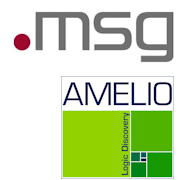 msg Relies on AMELIO Logic Discovery for Modernizing Applications
msg Relies on AMELIO Logic Discovery for Modernizing Applications
On behalf of a large insurer, msg Systems ag Switzerland was looking for an analysis tool to rewrite parts of a business-critical core application. For this purpose, a tool should be found that automatically extracts the business logic from the application and displays it clearly so that it can be understood more quickly and transferred into a new language.
The msg is convinced that AMELIO is a great help with modernization and offers support with the conversion.
We would be happy to show you the capabilities of AMELIO Logic Discovery using your examples.
You can find out more about the project here:
msg Relies on AMELIO Logic Discovery for Modernizing Applications
msg Relies on AMELIO Logic Discovery for Modernizing Applications
 On behalf of a large insurer, msg Systems ag Switzerland was looking for an analysis tool to rewrite parts of a business-critical core application. For this purpose, a tool should be found that automatically extracts the business logic from the application and displays it clearly so that it can be understood more quickly and transferred into a new language.
On behalf of a large insurer, msg Systems ag Switzerland was looking for an analysis tool to rewrite parts of a business-critical core application. For this purpose, a tool should be found that automatically extracts the business logic from the application and displays it clearly so that it can be understood more quickly and transferred into a new language.
There are special hurdles to overcome in modernization projects: On the one hand, some of the original developers are no longer available. Instead, the applications are maintained by their "heirs" who, however, know nothing of the origins and the reasons for certain decisions. On the other hand, the existing documentation is used to support the maintenance. But for modernization or rewriting information is required that the documentation usually does not provide. Thus, the only reliable source is the source code itself. The problem is aggravated when a service provider wants to understand or modernize a customer's application. So how can the knowledge necessary for modernization be transferred and possibly even regained?
The msg is confronted with this task - for a large insurance company, parts of a business-critical core application should be rewritten. The existing application was developed in COBOL and PL/I, partly native and partly generated with Delta ADS. The msg decided to evaluate the performance of AMELIO Logic Discovery. A part of this application has been removed and analyzed and assessed manually and automatically. It quickly became clear:
"AMELIO Logic Discovery helps and presents everything very clearly!"
msg Systems
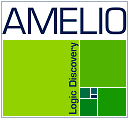 AMELIO works model-oriented and makes the analysis results available as language-neutral documentation. AMELIO is configurable and can be perfectly adapted to the needs of a (modernization) project.
AMELIO works model-oriented and makes the analysis results available as language-neutral documentation. AMELIO is configurable and can be perfectly adapted to the needs of a (modernization) project.
Clear Recommendation for AMELIO
The msg is convinced that AMELIO is a great help with modernization and offers support with the conversion. The knowledge of an application can be built up faster, easier and more securely so that it can be rewritten more efficiently.
About the msg Group
The msg systems ag Switzerland is part of msg, an independent group of companies with more than 8,500 employees. The msg group is active in 28 countries in the automotive, banking, consumer products, food, healthcare, insurance, life science & chemicals, manufacturing, public sector, telecommunications, travel & logistics and utilities sectors and supports its customers in their digital transformation.
See for Yourself
Do you also have business-critical core applications and are looking for a way to analyze them fully automatically and reliably?
Then contact us. We would be happy to show you the capabilities of AMELIO Logic Discovery using your examples.
 RDW Removes Technical Debts using Delta’s Automated Solution
RDW Removes Technical Debts using Delta’s Automated Solution
Existing applications have accumulated a lot of technical debt over the years. Removing it could speed up maintenance significantly. In reality the task of improve the software by removing the obsolete parts is seldom performed. The risk of introducing errors and the cost of testing is the biggest reason for not doing anything.
RDW has been able to take up the task of removing technical debt in a secure manner. Delta’s AMELIO Modernization Platform plays a key role in this endeavour.
You can find out more about the project here:
RDW Removes Technical Debts using Delta’s Automated Solution
RDW Removes Technical Debts using Delta’s Automated Solution
 Existing applications have accumulated a lot of technical debt over the years. Removing it could speed up maintenance significantly. In reality the task of improve the software by removing the obsolete parts is seldom performed. The risk of introducing errors and the cost of testing is the biggest reason for not doing anything.
Existing applications have accumulated a lot of technical debt over the years. Removing it could speed up maintenance significantly. In reality the task of improve the software by removing the obsolete parts is seldom performed. The risk of introducing errors and the cost of testing is the biggest reason for not doing anything.
RDW has been able to take up the task of removing technical debt in a secure manner. Delta’s AMELIO Modernization Platform plays a key role in this endeavour.
Technical Debt hampers Application Maintenance
The Netherlands Vehicle Authority (RDW) is a long-time user of Delta ADS, Delta Software Technology’s software development product suite. In the past decades, the key applications have grown and also been migrated to different platforms. All these changes over the years have decreased the maintainability of the application portfolio. To improve the maintainability of this application portfolio the decision was made to invest in the removal of technical debts (and 'Clean Code').
The task of discovering and safely removing technical debts is a complex one. To remove or change code from a program that you have written yourself might be an option but if it has been written years ago by a predecessor that is not available to consult is another question. It is not without reason that many programmers do not trust themselves to perform these type of program changes. They have a rightful fear of cascading side effects of a change.
Another obstacle arises because removing the technical debts involves many programs that are depending on each other to work correctly. The fact that all these programs must be changed at the same time leads to freezing them all preventing all other functional maintenance that is needed for the business.
Database Access – an Example of Reducing Technical Debt
RDW had implemented a new architecture for the database access in their applications which co-exists with an older way of accessing the data. This hybrid architecture was more and more considered to be a technical debt. A manual change was started for the less complex situations but in general a large portion remained and with the manual approach the completion would have taken many more years.
The remaining 9,000+ data access calls (of originally 16,000) contained also the most complex ones, some of them not yet made available in the new architecture. RDW decided to make use of Delta’s AMELIO Modernization Platform to perform an automated replacement of the remaining old data access architecture by the new one.
Transformation Step-by-Step
Knowing that the new data access architecture did not yet support all features of the old architecture, the chosen approach was to use the AMELIO Modernization Platform to create a learning factory to discover and perform all the necessary changes in the application sources. That didn’t have to be perfect for all possibilities in the beginning. No time was lost with specifying everything in all detail, the specification for the already performed manual transformation was used as a starting point. As a first step, the simpler data access types were analysed and transformed with the goal to make the programs productive even when they still contained other or more complex data access types using the old architecture. The next step was to remove the next type of data access, where the result from the previous step could be input as well as programs that were not handled by the factory before. This iterative process continued until at the end also the most complex data accesses were transformed.
"In the end our decision paid off. Using an automated approach also means almost no freeze and the possibility to change implementations at a very late stage. It enabled us to improve on the end result without any problem. With a manual approach, we would have passed the moment to do something in a different way long before."
Roland Römer - Product Owner RDW
Continuously Moving Forward
After the migration to the new Data Access architecture the AMELIO Modernization Platform will now be used as an environment to perform other mass changes in the application sources that will reduce the technical debt.
"We now see Delta’s AMELIO Modernization Platform as a kind of washing machine. As long as we chose the right program it will remove a ‘stain’ (technical debt) from our applications. It’s a great solution for when we have mass changes that need to be carried out on our application portfolio."
Gert-Jan Theuwissen - Division Manager RDW ICT
 About RDW
About RDW
RDW ICT is the IT service provider of the national vehicle authority of The Netherlands. Their main tasks include the inspection and registration of vehicles, market authorisation of vehicles, administration of driving licenses, information services for the police – in total more than 300 million transactions annually. RDW repeatedly has been awarded as the best and most innovative government organization, for best management and best annual results.
Convince Yourself
Interested in reducing the technical debt in your applications? Contact us and let us prepare a demo with some of your sources.
Download Language: Englisch - Version: MT21102-02

Software also accumulates dust over the years. Because of the effort and risk, a removal of the dust is often avoided. On the other hand, the maintenance is becoming increasingly difficult. If the proven code should be used continuously, either in maintenance or as a basis for rewriting, it is worth cleaning up the applications. To save the time-consuming manual work and to minimize the risks, we have developed a washing machine for software for this task.
Read moreDownload Language: Englisch - Version: mt21093.02

Existing applications have accumulated a lot of technical debt over the years. Removing it could speed up maintenance significantly. In reality the task of improve the software by removing the obsolete parts is seldom performed. The risk of introducing errors and the cost of testing is the biggest reason for not doing anything.
Read moreDownload Language: Englisch - Version: MT21100.01

RDW has been developing and maintaining its core business applications for over 30 years. The applications work reliably, but over time technical debts have accumulated that make maintenance and further development difficult. The daily business as well as the size and criticality of the application do not allow a manual clean-up of the software. The solu tion for the problem: a washing machine that performs an automated cleaning of the soft ware from its technical debts.
Read more
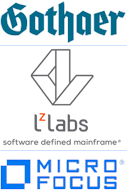 Review: Our Highlights 2020
Review: Our Highlights 2020
Home office and social distancing dominated a large part of this year and required organizational changes. Nevertheless, we managed to implement business-critical projects on time and on budget together with our customers and partners. Once again it has been shown how much can be achieved by using automated solutions.
Here you will find our Highlights:
- Gothaer Systems starts migrating its IBM IMS Databases
- LzLabs teams up with Delta Software to ensure seamless application maintenance & development
- Insurance company assesses unified Micro Focus development environment with Delta Software
Download Newsletter
Download Language: Englisch - Version: nl21021.01

Content
- 3 Important Steps for the Sustainable Software Modernisation
- msg Relies on AMELIO Logic Discovery for Modernizing Applications
- RDW Removes Technical Debts using Delta’s Automated Solution
- Review: Our Highlights 2020

